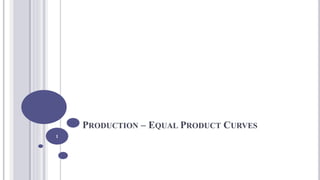
Equal product curves
- 1. PRODUCTION – EQUAL PRODUCT CURVES 1
- 2. PRODUCTION – EQUAL PRODUCT CURVES Isoquant is also called as equal product curve or production indifference curve or constant product curve. Isoquant indicates various combinations of two factors of production which give the same level of output per unit of time. Just as an indifference curve represents various combinations of two goods which give a consumer equal amount of satisfaction, an iso-product curve shows all possible combinations of two inputs physically capable of producing a given level of output. Since an iso-product curve represents those combinations which will result in the production of an equal quantity of output, the producer would be indifferent between them. 2
- 3. WHAT ARE ISO-PRODUCT CURVES OR EQUAL PRODUCT CURVES? It is the business of a manufacturer to hit on the cheapest or the lowest cost method to produce a given output out of the several alternative methods open to him. There are a large number of combinations of inputs which can produce a given output and the producer has to select the most economical combination out of these. This will be an equilibrium position for him. In recent years, a new technique has been developed to study the theory of production and to show the equilibrium of a producer regarding combination of factors. This technique is of Iso-product a curve which is a parallel concept to the indifference curves in the theory of consumption. 3
- 4. FACTOR COMBINATIONS TO PRODUCE A GIVEN OR LEVEL OF OUTPUT: The concept of isoquant can be easily understood from above Table. It is presumed that two factors labor and capital are being employed to produce a product. Each of the factor combinations A. B, C, D and E produces the same level of output, say 100 units. To start with, factor combination A consisting of 1 unit of labor and 12 units of capital produces the given 100 units of output. 4
- 5. Similarly, combination B consisting of 2 units of labor and 8 units of capital, combination C consisting of 3 units of labor and 5 units of capital, combination D consisting of 4 units of labor and 3 units of capital, combination E consisting of 5 units of labor and 2 units of capital are capable of producing the same amount of output, i.e., 100 units. We have plotted all these combinations and by joining them we obtain an isoquant showing that every combination represented on it can produce 100 units of output. 5
- 6. Though isoquants are similar to be indifference curves of the theory of consumer’s behavior, there is one important difference between the two. An indifference curve represents all those combinations of two goods which provide the same satisfaction or utility to a consumer but no attempt is made to specify the level of utility in exact quantitative terms it stands for. This is so because the cardinal measurement of satisfaction or utility in unambiguous thermos is not possible. That is why we usually label indifference curves by ordinal numbers as I, II, III etc. indicating that a higher indifference curve represents a higher level of satisfaction than a lower one, but the information as to how much one level of satisfaction is greater than another is not provided. 6
- 7. On the other hand, we can label isoquants in the physical units of output without any difficulty. Production of a good being a physical phenomenon lends itself easily to absolute measurement in physical units. Since each isoquant represents a specified level of production, it is possible to say by how much one isoquant indicates greater or less production than another. we have drawn an isoquant-map or equal- product map with a set of four isoquants which represent 100 units, 120 units, 140 units and 160 units of output respectively. Then, from this set of isoquants it is very easy to judge by how much production level on one isoquant curve is greater or less than on another. 7
- 8. PROPERTIES OF EQUAL PRODUCT CURVES Properties of iso-product curves are the same as those of indifference curves. Their properties can also be proved in the same manner as in the case of indifference curves. The following are the important properties of iso-product curves: (I)Sloping Downwards- Iso-product curves slope downwards from left to right. This is so because if the quantity of a factor X is increased, the quantity of factor Y must be decreased so as to maintain the same level of output. (ii)Convexity- Iso-product curves are convex to the origin. Thus, it is the diminishing marginal rate of substitution which is a realistic phenomenon and due to which the iso- product curves are convex to the origin. (iii)Non-intersecting-Two iso-product curves cannot cut each other. 8
